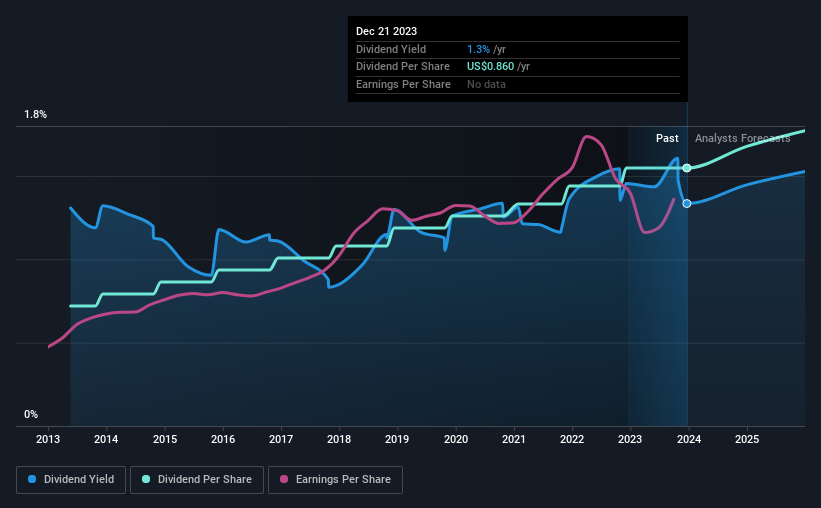SEI Investments Company (NASDAQ:SEIC) is about to trade ex-dividend in the next 4 days. Typically, the ex-dividend date is one business day before the record date which is the date on which a company determines the shareholders eligible to receive a dividend. It is important to be aware of the ex-dividend date because any trade on the stock needs to have been settled on or before the record date. Accordingly, SEI Investments investors that purchase the stock on or after the 27th of December will not receive the dividend, which will be paid on the 9th of January.
The company’s upcoming dividend is US$0.46 a share, following on from the last 12 months, when the company distributed a total of US$0.86 per share to shareholders. Last year’s total dividend payments show that SEI Investments has a trailing yield of 1.3% on the current share price of $64.43. We love seeing companies pay a dividend, but it’s also important to be sure that laying the golden eggs isn’t going to kill our golden goose! So we need to investigate whether SEI Investments can afford its dividend, and if the dividend could grow.
View our latest analysis for SEI Investments
Dividends are typically paid from company earnings. If a company pays more in dividends than it earned in profit, then the dividend could be unsustainable. That’s why it’s good to see SEI Investments paying out a modest 25% of its earnings.
When a company paid out less in dividends than it earned in profit, this generally suggests its dividend is affordable. The lower the % of its profit that it pays out, the greater the margin of safety for the dividend if the business enters a downturn.
Click here to see the company’s payout ratio, plus analyst estimates of its future dividends.
Have Earnings And Dividends Been Growing?
Companies with consistently growing earnings per share generally make the best dividend stocks, as they usually find it easier to grow dividends per share. Investors love dividends, so if earnings fall and the dividend is reduced, expect a stock to be sold off heavily at the same time. This is why it’s a relief to see SEI Investments earnings per share are up 6.2% per annum over the last five years.
The main way most investors will assess a company’s dividend prospects is by checking the historical rate of dividend growth. Since the start of our data, 10 years ago, SEI Investments has lifted its dividend by approximately 8.0% a year on average. We’re glad to see dividends rising alongside earnings over a number of years, which may be a sign the company intends to share the growth with shareholders.
To Sum It Up
Is SEI Investments an attractive dividend stock, or better left on the shelf? SEI Investments has seen its earnings per share grow slowly in recent years, and the company reinvests more than half of its profits in the business, which generally bodes well for its future prospects. In summary, SEI Investments appears to have some promise as a dividend stock, and we’d suggest taking a closer look at it.
So while SEI Investments looks good from a dividend perspective, it’s always worthwhile being up to date with the risks involved in this stock. For example – SEI Investments has 1 warning sign we think you should be aware of.
A common investing mistake is buying the first interesting stock you see. Here you can find a full list of high-yield dividend stocks.
Have feedback on this article? Concerned about the content? Get in touch with us directly. Alternatively, email editorial-team (at) simplywallst.com.
This article by Simply Wall St is general in nature. We provide commentary based on historical data and analyst forecasts only using an unbiased methodology and our articles are not intended to be financial advice. It does not constitute a recommendation to buy or sell any stock, and does not take account of your objectives, or your financial situation. We aim to bring you long-term focused analysis driven by fundamental data. Note that our analysis may not factor in the latest price-sensitive company announcements or qualitative material. Simply Wall St has no position in any stocks mentioned.



